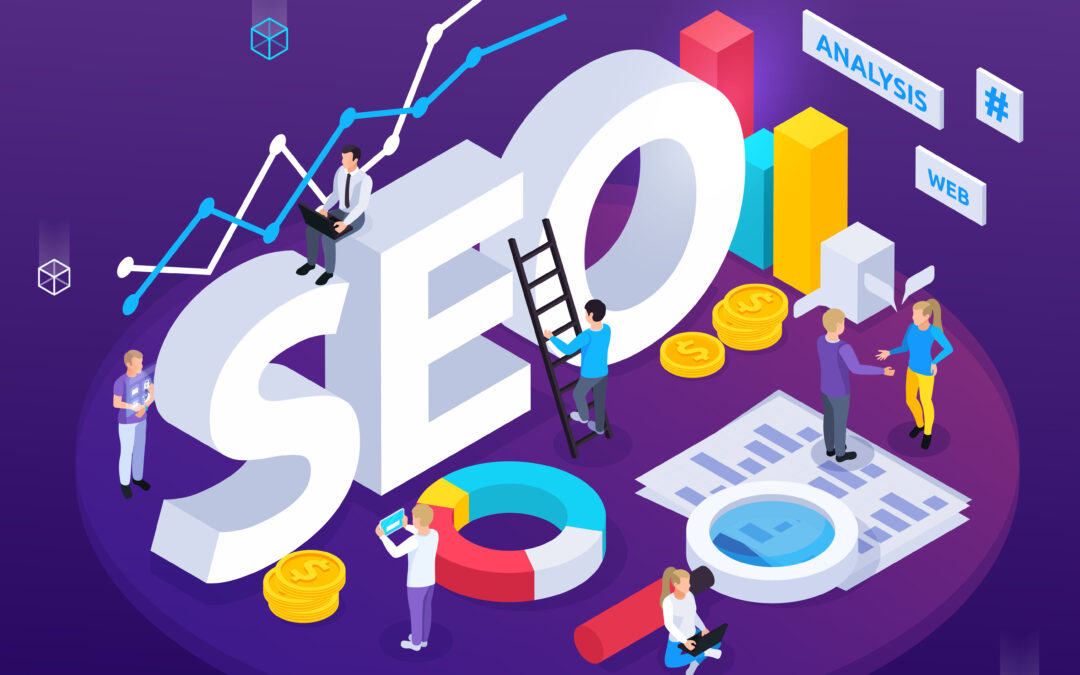The term SEO or Search Engine Optimization is believed to be coined by Bob Heyman and Leland Harden in the 1990s. It first appeared on Wikipedia in 2003.
Many names are associated with the popularization of SEO, like Danny Sullivan and Jason Gambert, and Webstep Marketing Agency was the first firm to employ SEO as a tool for marketing. Ever since then, its potency has been identified, and today.
Search Engine Optimization Strategy is used all over the world, with 70% of businesses believing SEO is better than PPC. Now that we are briefly acquainted with the origin of SEO let us now move to the more crucial questions.
What is SEO?
SEO or Search Engine Optimization is a powerful technique to drive traffic to your website by boosting your website’s position on the search engine results.
In simple terms, it brings up the ranking of your website so the target audience can easily reach you. A few factors that improve the position of your ranking are keywords, site speed, mobile-friendliness, crawlability, and so on.
According to statistics, 75% of people never scroll past the first page of search engines. This figure most appropriately portrays why your website should rank high on the Search engine.
To understand SEO, we first need to get a glimpse of how search engines work. Here, we shall talk about Google specifically; since it is the most frequently used search engine.
How does Google work?
Google is the most preferred search engine worldwide, therefore, knowing how it functions is significant to understanding SEO better. There are several search engines, but in the evolution of SEO, Google is what matters the most because it accounts for almost 93% of search engine use.
Here is how Google and SEO function together in a nutshell.
- Google incorporates computer programs called web crawlers, spiders, or bots to crawl the web. After these programs come across a new page, they add an index to it.
- Google has an algorithm that is aimed at providing users with the most relevant answers to their questions and renders them the best experience possible.
- The algorithm regulates which pages are hauled from the index and displayed on the results.
- What SEO does is; it structures a particular website according to Google’s algorithm, thereby increasing the chances of displaying your website higher on the search engine results.
- The changes in the algorithm have to be monitored to test what actually works in the search engines.
The SEO should never feel spammy since Google’s objective is to lay out the most pertinent answer to the user’s query.
What are the Four Pillars of SEO strategy?
Now that we have understood the basic working of search engines let’s delve deeper into SEO. When we say something is the pillar of other, we imply that it is the backbone or foundation of it. Owing to the fact that we are aware of the basics of SEO.
let’s proceed with understanding the Four Pillars of SEO. The four areas to focus on when creating an SEO strategy:
- Technical SEO: How is the crawler crawling & indexing your website content.
- Content: How well is your website addressing your customers for queries related to your business
- On-site SEO: Website content & HTML optimization.
- Off-site SEO: Building website Authority with backlinks.
Technical SEO
Technical SEO is the first and the most important of the pillars of SEO. As its name suggests, it is the technical backend of your website.
To display your webpage on the search engine results, the search engine primarily has to discover it. This is done through programs that find, crawl, and index your website.
Your website has files and directives that guide the search engine spiders on how they would like to be crawled and indexed. A few directives, for instance, are – HTTP connections, speed, site structure, responsiveness, and so on.
Technical SEO might sound intimidating, but it ensures a search engine will read your content and explore your webpage, maximizing the chances of improving your rank and, eventually, your reach to the audience.

Most of the modern-day CMS are integrated in a way that they take care of Technical SEO fixtures themselves. Still, to check technical SEO issues on the website, you can make use of the tools like Screaming frog.
Content and User-engagement
Content and user engagement is another most important pillar of SEO. What search engines evaluate when they run across your website is the content. Google prioritizes your website that exhibits E-A-T (expertise, authority, and trustworthiness). Search engines extract the authenticity and worth of the webpage based on its content.
A few prerequisites for good content are quality, keyword usage, updated and fresh information, integration of meaningful text, images, and videos, and lastly, relevancy with the search queries.
Solely having flawless content is of no use if users are not able to notice your webpage and interact with it. A few aspects to consider to allure and engage users are a logical information flow, a simple and visually appealing presentation of a website that conveys trust, authority, and the spirit of your brand, easy usability, and an enjoyable experience.
On-site SEO
Optimizing is a vast term. After you have created a well-structured site, what do you do next to drive traffic to your page?

Work on optimizing the core elements of your website! This is termed on-site SEO and involves developing on-site elements through page titles and meta descriptions, which craft the snippets of information you see on the search engine results page, adding alternative text on images, inserting internal links, and appending structured data, and so on. You must consider your target audience when optimizing your website, so you adhere to their requirements appropriately and get to reach them efficiently.
Off-site SEO
Search engines won’t trust you merely because your own website is well-furnished and optimized. Maintaining Off-site SEO is equally important to developing strong rankings. The authenticity and caliber of your website are accepted only if your online presence on other platforms is strong enough. For instance, no matter how fancy and crisp your website is; if there is limited proof of your brand being the best, search engines will not consider it. Therefore, expanding your brand on other online platforms becomes necessary.
Links, local search, and social media are powerful determinants of your authority. Links that point to your website from other websites, a google map listing, or a well-maintained social media presence can greatly impact your ranking. All of these elements form a segment of Off-page SEO, which is among the last SEO pillars.

The above-mentioned 4 pillars of SEO, when put to use together accurately, can help you improve your ranking on the search results page and assist you to reach audiences with ease. Though it sounds daunting, once you are well-versed with these SEO strategies and know the correct tools and elements to implement them, you can easily increase the ranking of your page, thereby improving visibility, maximizing brand awareness, and getting quality traffic.
SEO can be complicated since there is a vast amount of data on the search engines. To stand out and have Google recognize your website and rank it on its first page of results is not an easy task and requires extensive research, analysis, and consistent efforts. So, stay updated with the latest amendments in the field and use the right strategies to achieve the best results.
FAQ’S
How long does it take to get a higher ranking on Google?
It can’t be said with certitude how long your ranking will take. You cannot expect it to rank overnight or within a few weeks. The time taken can range anywhere from 6 months to one year based on the level of resources you allocate to your strategy and the level of competition.
Are there specific ranking factors that Google considers important?
Initially, three ranking factors, namely links, content, and Rank Brain, were confirmed by Google as important factors for ranking. Now, however, with deeper analysis, other factors like time on site, total referring domains, content length, followed backlinks, and more have been highlighted.
How do you decide on a keyword for your website?
To decide on a keyword, you must consider your target audience. Recognize the right seed words, i.e., a short one to a two-word keyword that helps people find your business. Find relevant keyword phrases that branch off from the concept of seed keyword. Ideally, keywords should have high search volume and low competition. You can use online tools to find the most appropriate keywords.
Is website ranking hindered by duplicated content?
Yes! If you copy-paste huge chunks of content from other websites, you are making a big mistake. Plagiarized content is not acceptable by search engines. Therefore, make sure you create unique and fresh content.
Should your business utilize SEO?
According to statistics, organic search is responsible for 53% of total site traffic. If you don’t leverage this, your competitors certainly will. Whether you are a local business, sell online, or are a global enterprise, paying attention to SEO is important for your business to thrive. Where PPC demands charges for every click on your website, SEO is a one-time investment, and once your page ranks organically on the search engines, this traffic is essentially free.

